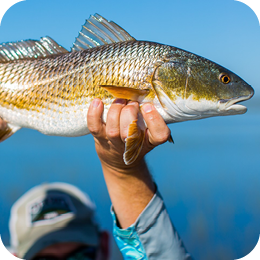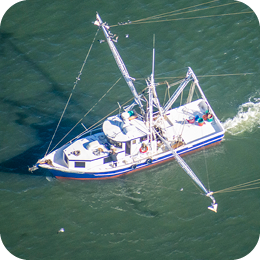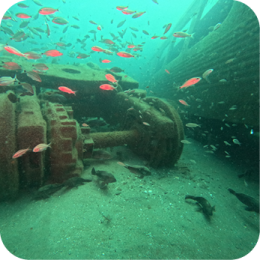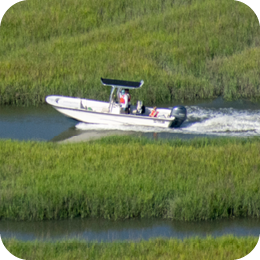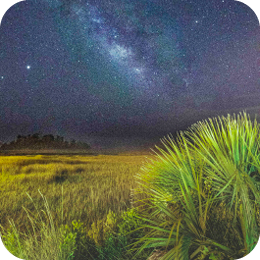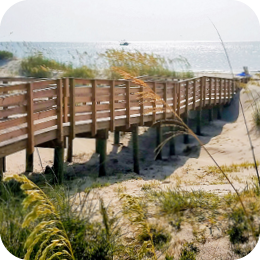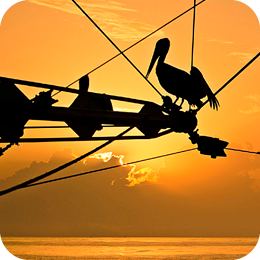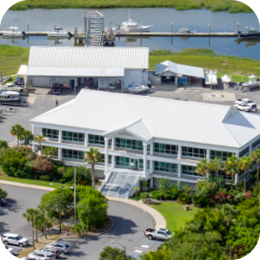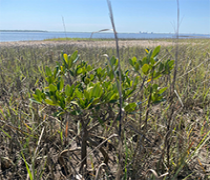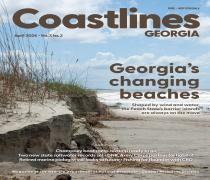Coastal Incentive Grant Program
The Coastal Incentive Grant (CIG) Program is a competitive pass-through subgrant program made possible by a grant to GA DNR from the National Oceanic and Atmospheric Administration (NOAA) through Congressional funding pursuant to the Coastal Zone Management Act. Each year, the GCMP allocates a portion of its federal funding to the Coastal Incentive Grants. These subgrants may be awarded to qualified county and municipal governments, regional commissions, state-affiliated research or educational institutions, or state agencies (except GADNR), provided the project takes place entirely within the eleven-county service area of the program. The CIG Program service area includes Brantley, Bryan, Camden, Chatham, Charlton, Effingham, Glynn, Liberty, Long, McIntosh, and Wayne counties. The program cycle that makes this opportunity possible is indicated below, however the CIG Public Notice should be read every year when advertised for program specific details. See the links below for more information.
![]() Application Instructions Cycle 28 PDF (REQUIRED Reading)
Application Instructions Cycle 28 PDF (REQUIRED Reading)
![]() CIG Cycle 28 Workshop PowerPoint PDF (Recommended Reading)
CIG Cycle 28 Workshop PowerPoint PDF (Recommended Reading)
![]() Frequently Asked Questions PDF (Recommended Reading)
Frequently Asked Questions PDF (Recommended Reading)
Coastal Incentive Grant Request for Proposals
The ![]() Request for Proposal for the Coastal Incentive Grant for Cycle 28 (PDF) is now open. Pre-applications will be due COB (4:30pm EST) Friday, December 6, 2024.
Request for Proposal for the Coastal Incentive Grant for Cycle 28 (PDF) is now open. Pre-applications will be due COB (4:30pm EST) Friday, December 6, 2024.
CIG Cycle 28 Workshops
Coastal incentive grant workshops provide an introduction to the application process and requirements of the CIG program. It is recommended that first time applicants attend one of the webinars.
- Register for the Oct 8, 2024, 09:00 AM Eastern Time webinar here.
- Register for the Oct 9, 2024, 12:30 PM Eastern Time webinar here.
- Register for the Oct 10, 2024, 03:00 PM Eastern Time webinar here.
The CIG Program Cycle
- July: Coastal Advisory Council Annual Meeting (establishes CIG themes and conditions)
- August: GADNR Board of Natural Resources approves CIG Public Notice
- September: Advertisement of CIG Public Notice
- December: CIG Pre-Application Due (competitive)
- January: CIG Pre-Application Review Team Meeting
- February: CIG Full Application Due (by invitation only)
- March: CIG Technical Review Committee Meeting (full application ranking)
- April: GADNR grant application due to NOAA (including recommended CIG subgrants)
- July/August: NOAA approves GADNR application
- August/September: GADNR and CIG applicant sign subgrant award contracts for start date of October 1st
Pre-Application Review Process
The Coastal Incentive Grant opportunity will involve a competitive pre-application process followed by an invitation only competitive full application process. Pre-applications will be submitted via the online portal by 4:30 pm on the first Friday of December (December 6, 2024). Following the submittal of the pre-application, the Pre-Application Review Team will review and competitively rank the pre-applications based on 1) applicability to the Georgia Coastal Management Program, 2) a demonstrated Coastal Need, 3) clear Project Goals, 4) Budget Soundness, 5) an applicant’s Past Performance, and 6) relationship to other federal funding.
After January 10, 2025, the Grants Specialist will provide all applicants with either an invitation to submit a full application or a pre-application denial letter. Either letter will also provide Pre-Application Review Team feedback to the applicant with information that may improve their full application or future re-submittal opportunity.
![]() Sample Pre-Application Form PDF (Reference Document)
Sample Pre-Application Form PDF (Reference Document)
- Approved Project Theme Descriptions
Sustainable Communities
- Strengthen local capacity to implement sustainable approaches in planning and development
- Identify and preserve unique community qualities, historical and cultural features, including public education
- Design stormwater BMPs recommended by the Georgia Coastal Stormwater Supplement
Oceans and Wetlands
- Maintain or improve the qualities of wetlands
- Conserve and restore wetland habitats
- Improved the understanding of ocean and wetland habitats and functions
Public Access and Land Conservation
- Add or enhance physical access for the public to coastal water resources (i.e. rivers, wetlands, beaches)
- Public access planning in support of the "Outdoors Beyond Barriers" Initiative
- Conserve riparian habitats through acquisition
- Conserve, preserve and/or manage especially for SLR retreat
- Analysis of land conservation needs and opportunities for habitat protection
Disaster Resiliency and Coastal Hazards
- Improve understanding of coastal hazards and potential impacts
- Develop, implement or incorporate adaptation and mitigation strategies/plans or policies
- Strengthen local capacity to implement FEMA’s Community Rating System
Nature-Based Solutions
- Plan & design nature-based projects within the eleven (11) coastal county service area
Implement via low-cost construction
- Actions to protect, conserve, restore sustainable use and manage ecosystems in a way that addresses the needs of CRD
Full Application Review Process
Upon invitation, the CIG Full Applications will be due, via online submission portal, by 4:30 pm on February 7, 2025. Full Applications are also competitive and will be reviewed, scored, and ranked by the CIG Technical Review Committee. The 5-member CIG Technical Review Committee includes representatives from coastal resource management, the scientific/research community, local government, non-governmental organizations, and citizens-at-large. All applications are scored based on the applicable ![]() Project Evaluation Criteria for Research (PDF) or
Project Evaluation Criteria for Research (PDF) or ![]() Non-Research (PDF) applications.
Non-Research (PDF) applications.
Applicants will be notified by the Grants Specialist mid-April 2025 if they are preliminarily chosen for funding. Funding will be dependent upon NOAA's approval in August 2025 for project terms of October 1, 2025 through September 30, 2026. Year 2 of any 2-year proposals preliminarily chosen for funding will be entirely dependent upon the favorable federal approval of NOAA's budget.
- Application Documents
 Sample Full Application Form PDF (Reference Document)
Sample Full Application Form PDF (Reference Document) Full Application Budget Form PDF (REQUIRED Form)
Full Application Budget Form PDF (REQUIRED Form) Certification Form PDF (REQUIRED Form)
Certification Form PDF (REQUIRED Form) Sample Local Government Resolution PDF (Reference Document)
Sample Local Government Resolution PDF (Reference Document) GCMP Staff Letter of Acknowledgement (Word document, Recommended Document for Full Proposal)
GCMP Staff Letter of Acknowledgement (Word document, Recommended Document for Full Proposal) Data Management and Sharing Plan (PDF) (REQUIRED for projects disturbing soil)
Data Management and Sharing Plan (PDF) (REQUIRED for projects disturbing soil)
- GADNR CRD Research Needs
Coastal Hazards
- Economic cost of action vs. inaction related to coastal hazards
- Effects of Ocean Acidification in Coastal Georgia Waters
- Local Model Ordinances to address Climate Change Impacts
- Reference tide stations to orthometric datum for enhanced accuracy of calculations in reference to land elevations
Coastal Habitats
- Economic value of salt marshes via wave attenuation during storm surge
- Environmental and biological data related to health and/or status of Georgia's river drainage systems. Specific needs related to habitat requirements during early life stages of marine organisms
- Reach of tide in major riverine systems
- SLAMM data enhancements (bathymetry, salinity, elevation, etc.)
- Geospatial information for assessing priority species impacts
- Saltmarsh, freshwater marsh and oyster reefs for carbon sequestration
Water and sediment quality/quantity
- Bacterial transport – hydrology studies; what are the bacterial sources? (Transport and time-of-travel studies to estimate when a pollution plume would reach a coastal swimming beach)
- Bacterial issues in and around Georgia coastal marinas
- Correlations between DO levels and tannins in Georgia coastal rivers
- Effects of wetlands and land use practices on instream flows (at multiple scales from site to regional)
- Beachfront shoreline change modeling/predictive ability considerate of natural and anthropogenic inputs
- Appropriate DO criteria that is protective of aquatic species present
Marine Fisheries
- Estimates of hooking mortality in the catch-and-release recreational fisheries
- Complete knowledge of the life history of exploited estuarine and marine fishes indigenous to coastal Georgia
- Improve fishery assessments, with increased/coordinated fishery-dependent and fishery independent monitoring/surveys region-wide
- Characterization of discards associated with recreational fisheries, specifically Red Drum and Black Sea Bass
Green Growth/Stormwater Management
- Pre and post construction monitoring of effectiveness of LID BMP installations (including water quality and quantity impacts)
- Inventory of specific codes, ordinances, and/or individual practices that are hindering green development in coastal counties, including solutions to alleviate these roadblocks
- Future buildout analysis for coastal counties to demonstrate stormwater and flooding impacts with increasing impervious cover (including water quantity and quality impacts)
- Economic analysis of traditional subdivision development patterns versus “green” neighborhood developments utilizing local/regional examples
- Hydrologic analysis of tidally influenced stormwater infrastructure with future precipitation and future sea levels to identify and prioritize needed capacity improvements
Public Access
- Economic impact, public use trends, and needs assessment
- Identify public access areas for additional access or increased capacity at existing structures
- Low-Cost Construction and Land Acquisition Projects (306A)
Applications to support low-cost construction projects or acquisition of real property that provide access to coastal natural resources are accepted under the Coastal Incentive Grant program. NOAA is currently revising 306A Guidance and Checklist documentation. More information will be provided as documents are approved. Applications for low-cost construction or land acquisition projects require a site visit by DNR staff prior to submission of the full application. Additional requirements to the standard CIG Application for low-cost construction and land acquisition projects are as follows:
- The
 Section 306A Construction and Land Acquisition Guidance document (PDF) describes the Section 306A construction and land acquisition program, eligible project activities, and guidance for completion of the Section 306A Questionnaire, clearance letters, and title opinion or certification requirements.
Section 306A Construction and Land Acquisition Guidance document (PDF) describes the Section 306A construction and land acquisition program, eligible project activities, and guidance for completion of the Section 306A Questionnaire, clearance letters, and title opinion or certification requirements. - The Section 306A Questionnaire (
 PDF) MUST be completed and returned with your full application. CRD staff will use this form during their site visit (DO NOT sign the cover page yourself).
PDF) MUST be completed and returned with your full application. CRD staff will use this form during their site visit (DO NOT sign the cover page yourself). - Prior to beginning construction, all 306A projects must receive clearances from the State Historic Preservation Division (Section 106) and the US Fish and Wildlife Service (Section 107) stating that the proposed construction or land acquisition project will not have a significant impact, or specifying project conditions, upon Historic Resources, Endangered or Threatened Species, or Marine Fish. Follow this link to request clearance from the State Historic Preservation Division. To request clearance from the US Fish and Wildlife Service, enter your project information into the Information for Planning and Consultation (IPaC) portal. Obtain an official species list and send the list along with your project proposal to GAES_Assistance@fws.gov.
- An Attorney Title Opinion or a Certification of Real Property Ownership must be included with your full application (only one of these is necessary).
 Download templates for these documents (Word document).
Download templates for these documents (Word document).
Site plans and site maps must be included with your full application and must include details described in the Section 306A Construction and Land Acquisition Guidance document.
- The
 An official website of the State of Georgia.
An official website of the State of Georgia.





